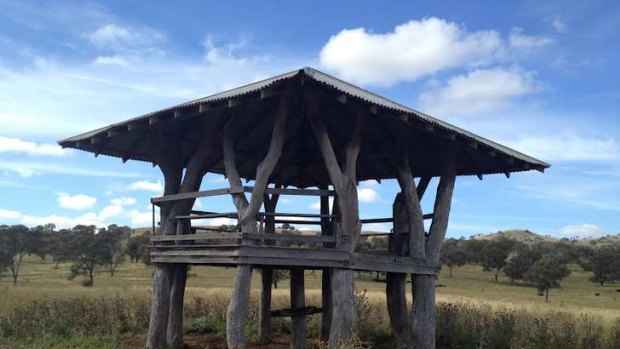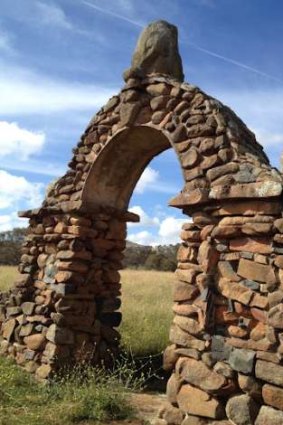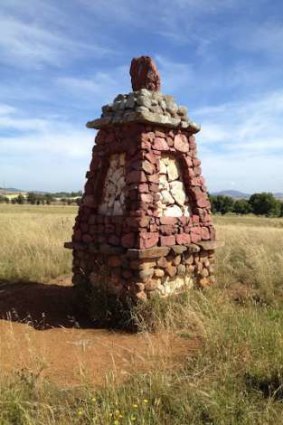
Environa bandstand photographed in 2012 by John EvansCredit: John Evans
Stonehenge featured in the news this week as a sight of celebration for Thursday’s solstice (summer solstice in the northern hemisphere and winter solstice here).
Having visited Stonehenge a number of times it has always struck me as odd that a monument of its stature sits among sprawling farmland and right next to a busy highway.
Equally, it might come as a surprise to many that Canberra has its own arrangement of historic stone monuments, also set in farmland and also near a busy highway.

Main arch at EnvironaCredit: John Evans
Now, while ours aren’t as well known as those at Stonehenge, nor anywhere near as old, they certainly leave a lasting impression on those who set eyes on them.
Far from being built as some ancient calendar for religious rituals, Canberra’s ‘‘stonehenge’’, scattered around farmland just beyond the Monaro Highway in Hume, is all that remains of a grand vision by 1920s developer-cum-town planner Henry Halloran.
Halloran had developed estates in other locations in NSW such as Coffs Harbour, so when it was announced that land in the newly developing federal capital would only be leasehold, the entrepreneurial Halloran purchased a large swathe of land just over the border in NSW near Tralee.
A number of bandstands or summer houses were also erected around the site
He then subdivided this into 1700 blocks and marketed it as ‘‘absolutely the nearest freehold land to the parliamentary and government centre’’.
Halloran’s sales brochure boasted that the exclusive estate, which he called Environa, was to be ‘‘a magnificent sub-division, the design a masterpiece of town planning on beautiful undulating land with far-reaching views and overlooking the wonderful city of Canberra’’.
To complement Environa’s exclusive address, Halloran designed its roads in concentric circles around grand tree-lined boulevards to which he gave a mix of exotic and parliamentary-themed names such as Rue de Paris and Speakers Way.

Stone pillar at EnvironaCredit: John Evans
In an attempt to further lure prospective buyers, Halloran constructed a series of striking stone works.
These included a grand archway which opened to an imposing avenue of stone pillars culminating in a 12-metre high obelisk topped by a marble bust of Sir Henry Parkes.
A number of large bandstands or summer houses crafted from undressed timber and corrugated iron were also erected at vantage spots around the country estate.
They were to be the centre of recreation activities and community gatherings at Environa.
However, Halloran’s grandiose scheme was unfortunately thwarted by the slower than expected growth of Canberra and the onset of the Great Depression, and despite several blocks being sold none were ever developed.
Today the property is owned by descendants of Halloran and recent photos indicate that the stone features, and at least one of the bandstands, are in reasonable condition.
I just wonder if in another 85 years Canberra’s ‘‘stonehenge’’ will still be standing, sentinel to Halloran’s failed vision.
FACT FILE
Environa is a private property and entry is prohibited without the owner’s consent. You can however, view from a distance many of the historic stone structures from a public road which runs behind Hume. To access this road, drive under the railway line at the end of Arnott Street in Hume and turn right. After 50-100 metres or so you should be able to make out some of the stone pillars in the paddocks on your left.
Did You Know: In her informative article Environa: Marketing a life-style near Canberra 80 years ago, which appeared in the October 2005 edition of National Library of Australia News, Jennifer Horsfield reports that the bust of Sir Henry Parkes, which stood atop the tallest pillar, was damaged by vandals shooting at it. As a result, it has been moved to a safer place inside the privately-owned Environa Homestead where, according to Horsfield, ‘‘it is still imposing, in spite of the chips on Sir Henry’s ears and nose’’.
Google Maps: If you zoom in enough on the area between Hume and Jerrabomberra you will see the intricate layout of concentric circles, part of the proposed streetscape of Environa.
More: There is a chapter on the abandoned city in the booklet Undiscovered Canberra, by A. J. Mortlock and B. Anderson, published by ANU Press in 1978. The booklet’s cover also features one of Environa’s bandstands.
Sign up for the Traveller newsletter
The latest travel news, tips and inspiration delivered to your inbox. Sign up now.